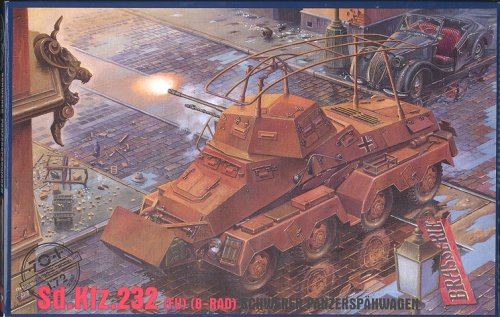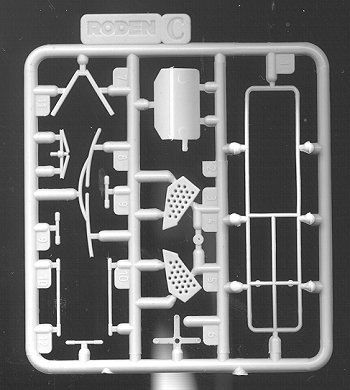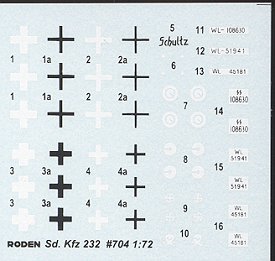
|
KIT: |
Roden 1/72 SdKfz 232 |
|
KIT # |
704 |
|
PRICE: |
$9.98 (8.97 at Squadron) |
|
DECALS: |
four options |
|
REVIEWER: |
Scott Van Aken |
|
NOTES: |

|
HISTORY |
Thanks to
Roden for the historical background.
|
THE KIT |

Being somewhat lazy
and also feeling that since this is the third time you've seen the same
basic kit, I decided to show only the new sprue. If you want to see the
rest of the bits, then check out the 231
preview. It also seems as if the parts are a bit cleaner than on the
previous kit. By that I mean that on this molding, there were no sink
areas on the wheels as I found on the 231 kit. The extra bits are for the
radio antenna array and for that thing on the front that I assume is some
sort of armored guard to protect additional fuel cans or other equipment
carried on the front. Those who wish to make a standard SdKfz 231 from
this kit can do so simply by leaving off all the stuff from the above
sprue.
Instructions are superb, providing clear construction and painting information. I'll caution the builder to make sure that the bits on the fenders are as close to the outside as they can be placed. My building experience showed that putting them too close to the inside will only result in difficulty attaching the fenders to the body. Decals are provided for three different vehicles. One from the 'Hermann Goering' division in Italy during 1944 and painted in overall panzer yellow. Another similarly painted vehicle of 5 'Wiking' SS Panzer Division in Russia during the spring of 1943 and shown on the box art. Finally, a panzer grey variant of the 'Herman Goering' motorized brigade in Rumania during 1941. Decals are very well printed and appear to be quite thin. I'd recommend using very warm or even hot water when applying these as that seems to be the best way to get results from these decals.
|
CONCLUSIONS |
I can recommend this as a very nice little kit and a pretty much trouble-free build. One does have to think ahead a bit to make sure that all the small parts will fit properly, but the end result will reward a careful builder.
Thanks to the fine folks at
 for supplying a
review kit. Visit them by clicking on the logo
for supplying a
review kit. Visit them by clicking on the logo
You can find this kit and many others at

If you would like your product reviewed fairly and quickly by a site that has over 200,000 visitors a month, please contact me or see other details in the Note to Contributors.